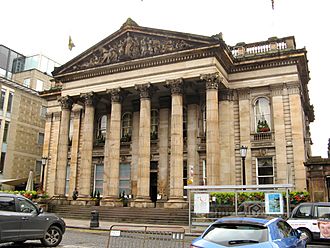The Dome, Edinburgh facts for kids

The Dome, George Street, Edinburgh
|
|
| Former names | Commercial Bank of Scotland |
|---|---|
Quick facts for kids General information |
|
| Architectural style | Greco-Roman |
| Town or city | New Town |
| Country | Scotland |
| Coordinates | 55°57′12″N 3°11′46″W / 55.95336°N 3.19603°W |
| Current tenants | Caledonian Heritable |
| Technical details | |
| Floor count | 2 |
| Design and construction | |
| Architect | David Rhind |
|
Listed Building – Category A
|
|
| Official name | 14 George Street, former Commercial Bank, incorporating boundary walls, railings and balustrades, flanking gateways and pavilions, and lamp standards |
| Type | Architectural |
| Designated | 13 January 1966 |
| Reference no. | LB28862 |
The Dome is a famous building in Edinburgh, Scotland. It's on George Street in the city's New Town. Today, it's a popular bar, restaurant, and nightclub. But it wasn't always like this!
The building was first built in 1847. It was the main office for the Commercial Bank of Scotland. David Rhind designed it in a Graeco-Roman style. The Dome stands where an older building, the Physicians' Hall, used to be. That hall was designed by James Craig, who planned the New Town. The Dome is a very important building. It is a category A listed building, meaning it's protected.
Contents
What Was Here Before? The Physicians' Hall
Before The Dome, the Physicians' Hall stood on this spot. James Craig designed it. He was the winner of a big competition in 1766 to plan Edinburgh's New Town.
The Physicians' Hall was built for the Royal College of Physicians of Edinburgh. It was a beautiful building. Its first stone was laid in 1776. The hall was 84-foot-long (26 m) at the front. It had a grand entrance with four tall Corinthian columns.
This building gave the College of Physicians a permanent home. They had moved around for many years. However, the hall wasn't quite right for their needs. It was built for teaching students and doctors. But it didn't work as well as they hoped. The College was offered a lot of money for the George Street site. So, they moved to Queen Street, where they still are today.
A New Era: The Commercial Bank
After the Physicians' Hall was mostly taken down, the empty land was ready for something new. Scotland's Commercial Bank bought the site. They hired architect David Rhind for a new project.
At this time, banks and businesses were becoming very important. People were investing more in commercial buildings. This was a big change in Scotland's architecture. Banks and insurance companies built grand new headquarters. David Rhind's work for the Commercial Bank was part of this trend.
The Commercial Bank building was designed to show unity. This was an important idea in society then. People said the building's art and details blended together. They created a "delightful unity."
Building the Bank: A Classical Look
David Rhind looked back to Greek society for his ideas. He wanted to bring a classical style to the new bank. This was a popular trend in Scottish architecture. It was called Greco-Roman style.
Rhind designed a truly magnificent building. The front of the bank has a grand entrance. It is called a Corinthian hexastyle portico. It is ninety-five feet wide. It has six tall columns, each thirty-five feet high. These columns have beautiful, detailed tops called capitals.
The building's style shows Doric order and Greek classicism. The windows are simple and arched. They are similar to designs by Andrea Palladio. The front part above the columns, called the architrave, looks like the Temple of Agrigento.
The amazing sculptures on the portico were made by Alexander Handyside Ritchie.
The Commercial Bank's Grand Interior
The Commercial Bank building was not just about ideas. It was also very beautiful. In April 1847, a newspaper called The Scotsman wrote about it. They said the front had "rich and massive architecture." They also said the inside was "gorgeous."
The interior also had a classical style. It featured columns and a central dome. David Rhind used light cleverly. He made the dome out of glass. This brought in lots of light and gave the building a modern feel.
The Dome Today
The Commercial Bank of Scotland later joined with other banks. It is now part of the Royal Bank of Scotland. But the original building, with its walls, windows, floors, and famous glass dome, is still there today.
David Rhind's design used light well with the glass dome. He also made great use of space with a large central area. The Dome is one of many buildings in the Greek Revival style. But it stands out on George Street. It has a stunning pediment and a long, rich history.


